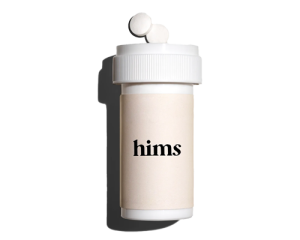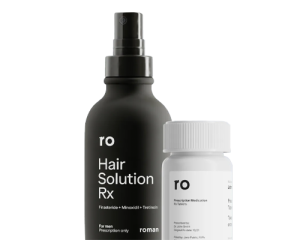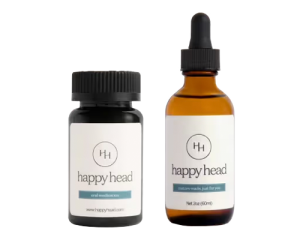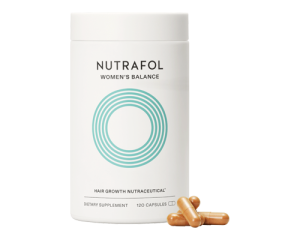- Starting cost for hair loss medication: $35 per month for oral minoxidil on Hims, $29 per month on Hers
- Hair loss medications available: Minoxidil (oral and topical), finasteride (oral and topical), and ketoconazole (topical)
- Subscription includes: Free delivery, unlimited messaging with prescriber
Best Hair Loss Medication in 2025: Reviewed by Our Experts
Key Takeaways
- Experts we spoke with say the top hair loss medication is minoxidil because it’s affordable and well-researched, but you will need patience to see results.
- Minoxidil comes in oral and topical formulas and is sometimes combined with other medications like finasteride and spironolactone.
- The cost of hair loss medications online ranges from $15–$79 per month
- The most common cause of hair loss is called androgenetic alopecia, which affects up to 50% of men and women.
Hair loss is a common issue, and successful treatment depends on finding the root cause. Hereditary hair loss, also called androgenetic hair loss or male-pattern baldness in men and female-pattern baldness in women, occurs when hair follicles are sensitive to certain hormones called androgens. It’s the most common form of hair loss, affecting up to 50% of people. The treatments can vary widely in both cost and effectiveness.
For this article, we reviewed clinical guidelines from the American Academy of Dermatology (AAD) and consulted with a team of hair loss experts, including board-certified dermatologists and trichologists. Christopher Chu, a dermatologist in Austin, Texas, who specializes in treating hair loss, shares his insights on the best available hair loss medications and treatments. Read on to learn more about the top hair loss medications, who they can be good for, and our experience with the platforms that offer them online.
Best hair loss medication in 2025
- Minoxidil: Best topical treatment
- Finasteride: Best for male-pattern hair loss
- Spironolactone: Best for female-pattern hair loss
- Nutrafol: Best supplement for hair loss
Minoxidil: Best topical treatment
Minoxidil was our experts’ top pick for the best topical hair loss medication. It’s a popular, research-backed option to support hair regrowth in men and women. Topical minoxidil is also available over the counter and is more affordable than finasteride and spironolactone, making it an accessible option for people experiencing hair loss.
Features
- Starting cost online: $16 per month (oral), $13 per month (topical)
- Forms available: Oral and topical
- Potential side effects: Itching, dryness, flakiness, irritation, and burning (topical); headache, nausea, vomiting, breast tenderness, swollen ankles, dizziness, rash, heart palpitations, irregular heartbeat, and hirsutism (unwanted hair growth in untreated areas) (oral)
- FDA-approved: Yes
- Prescription required: Oral minoxidil is a prescription-only medication; topical minoxidil can be found over the counter
- Other names: Loniten (oral), Rogaine (topical), and Theroxidil (topical)
Where to get online
- Hims (Oral starting at $35 per month, topical starting at $15 per month)
- Hers (Oral starting at $29 per month, topical starting at $13 per month)
- Ro (Oral starting at $30 per month, topical starting at $16 per month)
- Nurx (Oral starting at $16 per month, topical starting at $20 per month)
- Happy Head (Oral starting at $22 per month, topical starting at $59 per month)
Pros and cons
Pros
- Least expensive medication option on our list
- Topical minoxidil is available over the counter
- Can work for men and women
- Topical and oral minoxidil may have similar results
Cons
- Topical minoxidil can irritate the skin and scalp
- Requires daily treatment
- Treatment can take six to 12 months for results
- Results stop when medication is stopped

Unexpected effects of starting hair loss treatments: Hair shedding
For some, hair shedding can be an unexpected result of starting hair loss treatments, especially minoxidil. Dermatologist Christopher Chu explains that there isn’t much research on why this happens, but one theory is that the hair loss treatments may push out the older hairs while stimulating growth of new, thicker hairs. “This can happen within the first two months of treatment,” he said.
Hair shedding isn’t a common reaction to hair loss treatment, but it can be a normal one, and it’s temporary. It’s a good idea to let your prescriber know any changes you experience after starting treatment so they can adjust your treatment if necessary.
Our expert’s take on minoxidil
Chu recommends topical minoxidil as a well-researched and fairly well-tolerated medication for those dealing with hair thinning and hair loss. Compared to a minoxidil pill taken orally, topical minoxidil can be just as effective and is less likely to cause headaches.
Minoxidil encourages hair growth by increasing circulation to the scalp and encouraging hair follicles to grow longer and thicker hair. It prevents further hair loss by keeping hair follicles in the hair growth phase. There is some research to suggest that people using topical minoxidil can see results as soon as eight weeks (two months), but the AAD states that it can take up to 12 months to see noticeable results. In our survey of 275 adults using hair loss treatments, most respondents (63%) started noticing visible results from their treatment after three months.

Tips from an expert:
“Consistency is key. It’s critical to follow your treatment plan as prescribed and to understand that results take time. Typically, patients may start to notice improvements within three to six months, but it can take up to a year to see significant results. It’s also important to recognize that hair loss can sometimes worsen before it gets better, especially when starting treatments like minoxidil. This is often due to the hair follicles shedding old hairs to make way for new growth, which is a normal part of the process.” — Ross Kopelman, hair restoration surgeon at Kopelman Hair Restoration
Who may benefit
- People experiencing early hair loss or hair thinning
- People who want to a topical product
- People who have the patience to apply the product daily for six to 12 months
Who may consider other options
- People who don’t like or who can’t tolerate the product on their scalp
- People who can’t apply product to their scalp as part of a daily routine
- People who have health conditions or are taking medications that may interact with minoxidil
Topical minoxidil comes in the form of a foam, serum, or hair oil. Dermatologists may combine minoxidil with other topical or oral medications (like finasteride or spironolactone) to create an individualized hair loss treatment plan.

What to know about using topical minoxidil
Topical minoxidil may not be for everyone. Chu shares that some patients may not like the greasy feel of the product on their scalp or it might be hard to get into a daily routine of applying the product. The product must be applied to the scalp daily.
Common side effects of topical minoxidil can include itchiness, irritation, and burning on the scalp. Minoxidil can also cause sun sensitivity, meaning people using it topically may need to wear a hat or apply scalp sunscreen to protect their scalp. It’s important to wash your hands thoroughly after applying topical minoxidil to prevent the spread of the medication to other parts of the body.
Oral minoxidil is a drug used to treat hair loss as well as high blood pressure. Topical minoxidil also has the potential to impact blood pressure, but it’s not well-researched for its action on people with high blood pressure.
Even though topical minoxidil is available over the counter, it’s important to consult with a health care professional to understand whether a medicated treatment is right for you. Some people don’t respond to minoxidil because they lack an enzyme that converts minoxidil to its active form.
Finasteride: Best for men
Finasteride is a medication effective in preventing hair loss. It is available as an oral or topical medication, but both require a prescription. Chu commonly recommends finasteride as one of the options for men with male-pattern hair loss.
Features
- Starting cost online: $20 per month (oral), $35 per month (topical)
- Forms available: Oral and topical
- Potential side effects: Erectile dysfunction, decreased libido, and depression
- FDA-approved: Yes
- Prescription required: Yes
- Other names: Propecia (oral), Proscar (oral)
Where to get online
- Hims (Oral starting at $22 per month, topical starting at $35 per month in combination with minoxidil)
- Hers (Topical starting at $35 per month in combination with minoxidil)
- Ro (Oral starting at $20 per month, topical starting at $50 per month)
- Happy Head (Oral starting at $24 per month, topical starting at $79 per month)
Pros and cons
Pros
- May notice results sooner compared to taking minoxidil alone
- Comes in topical and oral forms
- Can be combined with minoxidil
Cons
- Not safe for women who are pregnant or may become pregnant
- Requires daily treatment
Our expert’s take on finasteride
Chu recommends finasteride as one of the top medication options for men with male-pattern hair loss. The medication works by blocking the conversion of the hormone testosterone to a form that causes hair follicles to shrink or “minimize.” Finasteride stops further hair loss and increases hair thickness by preventing the “minimization” of hair follicles.
People taking finasteride may notice results sooner than people taking minoxidil. The AAD states that it usually takes four months to notice improvement with finasteride.
Who may benefit
- Men who have male-pattern hair loss
- Postmenopausal women
Who may consider other options
- Women who plan on having children
- Children
- People who have a history of hormone-sensitive cancers, including prostate and breast cancer
Finasteride comes in a topical and oral form. The oral medication is more common, but recent research suggests that the topical form can be just as effective, with fewer side effects. We noticed that online platforms often combine topical finasteride with other active ingredients, such as minoxidil, to help treat hair loss in different ways.

What to know about using finasteride
Finasteride has the potential to cause birth defects in pregnant people. For that reason, professionals like Chu tend to recommend finasteride only to men, but they may also prescribe it to women who are postmenopausal. Health care providers may be cautious about prescribing finasteride to women on birth control as it is unknown whether there are any long-term effects should they become pregnant later.
In men, finasteride may cause side effects such as erectile dysfunction, decreased libido, and itching. It can also enlarge breast tissue in men and irritate the skin (rashes, itching). Especially with topical finasteride, it’s important to wash your hands thoroughly after applying the product to prevent contamination or irritation.
Finasteride affects hormone levels and, as a result, can increase the risk of certain hormone-sensitive cancers, such as prostate cancer. People who have a history of prostate cancer or breast cancer should talk to their doctor about whether finasteride is appropriate for them.
Spironolactone: Best for women
Spironolactone is a medication prescribed to treat high blood pressure and kidney diseases, but it’s also used to treat both hair loss and abnormal facial hair in people with polycystic ovarian syndrome (PCOS). Dermatologists like Chu may recommend spironolactone in women who are experiencing female-pattern hair loss, but it’s not appropriate for women who plan to have children.
Features
- Starting cost online: $49 per month (oral); $79 per month (topical)
- Forms available: Oral and topical
- Potential side effects: Vomiting, diarrhea, irregular menstrual periods, drowsiness, and muscle weakness
- FDA-approved: Yes
- Prescription required: Yes
- Other names: Aldactone and Carospir
Where to get online
Happy Head (Oral starting at $49 per month, topical starting at $79 per month)
Pros and cons
Pros
- Can be used with minoxidil
- May benefit women with acne or PCOS
Cons
- More expensive than minoxidil and finasteride
- Can affect blood pressure regulation
Our expert’s take on spironolactone
According to the AAD, spironolactone is for women with female-pattern hair loss. It works similarly to finasteride, by stopping further hair loss and increasing hair thickness. Experts like Chu may recommend spironolactone in combination with a medication like minoxidil if the patient can benefit from both.
Who may benefit
- Women with female-pattern hair loss
- Women with PCOS
- Women with acne and female-pattern hair loss
Who may consider other options
- Women who plan on having children
- People who are taking multiple medications or supplements
Dermatologists like Chu more commonly recommend the oral form of spironolactone than the topical form. Since spironolactone has multiple effects on the kidney, blood pressure, hormones, and skin health, it can be prescribed for people who have high blood pressure, PCOS, or acne alongside female-pattern hair loss.

What to know about using spironolactone
Side effects of spironolactone may include itchy scalp, irregular menstrual periods, and increased facial hair growth (despite being used to treat excess facial hair growth as well).
Like finasteride, spironolactone may cause birth defects in people who are pregnant. The medication can also interact with other drugs, including high blood pressure medications and blood thinners. Talk to your doctor before taking spironolactone if you’re taking multiple medications or supplements.
Nutrafol: Best supplement
We chose Nutrafol as the best supplement for hair loss because its over-the-counter formula has some small but positive clinical trial research behind its effectiveness. Chu says it’s a good option for people who want to try a supplement instead of a prescription medication.
Features
- Starting cost online: $70 per month when buying a six-month supply
- Forms available: Oral supplement
- Potential side effects: Digestive issues such as nausea or diarrhea
- FDA-approved: No
- Prescription required: No
Where to get online
- Nutrafol’s website (Starting at $70 per month)
Pros and cons
Pros
- Supplement-based option with positive results in research
- Few side effects reported
- Results supported by clinical trials in women, menopausal women, and men
Cons
- Monthly supply is more expensive than oral minoxidil
- Daily dose is four large capsules a day
Our expert’s take on Nutrafol
Nutrafol is a line of dietary supplements researched for people experiencing hair thinning. It includes physician-formulated products, and the platform offers consultations with naturopathic doctors for people with monthly subscriptions. The supplements have been studied in published clinical trials in women, menopausal women, and men. The results showed improvement in hair growth and minimal side effects after six months of use. Dermatologists like Chu may recommend Nutrafol as a natural option for people who aren’t ready to start using medications like minoxidil or finasteride.
The product is a blend of botanical extracts and nutrients that can help to address hormones, stress, and nutrition-related causes of hair thinning. The brand says people taking their product can expect results within three to six months, which is faster than traditional medications like minoxidil.
Who may benefit
- People who want to try a supplement for hair loss instead of a prescription medication
Who may consider other options
- People who are taking multiple medications or supplements
- People who may not be able to take four capsules daily
- People who are allergic to one or more of the supplement ingredients

What to know about using supplements for hair loss
Supplements (also called dietary supplements) are not regulated in the same way as drugs by the Food and Drug Administration (FDA). The FDA does not evaluate claims made by dietary supplement products, so consumers may not get the most research-backed information just by reading supplement labels.
The AAD recommends supplements such as biotin, zinc, and iron only when your blood tests indicate low levels of these nutrients. Taking too much of a nutrient when you have normal levels can cause other issues. For example, too much iron can cause iron poisoning, with early symptoms that include stomach pain and vomiting, according to the AAD.
Products with multiple active ingredients, like Nutrafol, have the potential to interact with other medications or supplements and health conditions. Talk to your doctor about which supplements would be appropriate for you, given your health and medication history.
Hair loss medication platforms
Online telehealth platforms may offer prescription hair loss medications that can be delivered to your door. These platforms can be a convenient alternative to picking up your prescription at the pharmacy. Here’s what we learned from our interviews with real hair loss medication users, our survey, and our testers.
Hims and Hers
Hims is a telemedicine platform for men that offers treatment for sexual health, mental health, weight management, and hair loss. Hers is a telemedicine platform that shares a parent company with Hims and specializes in treatments for the same concerns in women.
Hims and Hers both offer subscription-based treatments for hair loss. They have prescribers who review your health history and hair loss concerns before recommending a hair loss treatment. Prescription medications come in topical and oral forms, often combined with multiple active ingredients or nutrients like biotin. Nonprescription hair loss treatments by Hims and Hers include shampoos, conditioners, serums, and gummy vitamins.
We interviewed several Hims and Hers users, and tested the platforms to get some insights about what to expect on the platform. Our Hims tester filled out the online questionnaire and messaged with a prescriber before receiving a recommended treatment plan. Our tester shared that their prescriber explained the risks and benefits of the treatment. The tester thought it was a convenient and simple process.
The Hims and Hers users we interviewed experienced mixed results using the platforms’ products. A few Hims users noted slight changes such as decreased hair loss with over six months of use, but one user noticed more hair growth after 10 months of use. A few users agreed that they felt their results plateaued after some time.

Our focus group participant on Hims:
“I’ve seen some progress, you know, it definitely feels like the troublesome areas have been growing in. But it kind of feels like I’ve plateaued.”
Hims users shared that they appreciated the discreet packaging and convenience of regular deliveries. Both Hims and Hers users liked the convenience of adjusting their treatments online by messaging providers on the platform.

Our tester on Hims:
“Prescribers were very easy to get a hold of. At most, I’d have to wait 24 hours for a response via chat.”
If you try to contact your prescriber on Hims or Hers, there’s no guarantee that you’ll get the same one each time. One tester found that their prescribers didn’t offer very thorough responses unless they asked follow-up questions.
Customer reviews of Hims and Hers
On Better Business Bureau (BBB), the Hims and Hers company was rated 3.85 out of five stars with more than 4,700 reviews. It’s a BBB-accredited business with an A+ rating from the organization. Some reviewers mentioned that it was convenient to start, and others have started to notice hair growth after using Hims and Hers products. Others shared that they had trouble canceling their subscriptions and getting refunds.
“So far, so good! I’ve been impressed with the prompt replies to my questions from a real person. I have had few side effects from the medication I am using. It seems to be very professionally run.”
– Jane F., BBB.org
Some reviewers didn’t notice much change from their hair loss treatment.
“I’ve been using the dual prescription for hair growth for six months. There has been ZERO new hair to appear. Not even any “fuzz.” I received my last six-month order and will continue to use it. But I’m highly skeptical that there will be any success.”
– Ken W., BBB.org
Additional information
Hair loss treatments on Hims and Hers come in three- and six-month subscriptions. That means customers are charged every three or six months and receive three or six months worth of medication. Some of the over-the-counter products our tester chose came as a monthly subscription.
Each subscription includes free delivery, and subscriptions for prescription medication include a free provider evaluation and ongoing check-ins via messaging on the Hims and Hers platform.
You can pay with a credit or debit card, but not insurance.
You can contact Hims and Hers via email at support@forhims.com or by completing a contact form online.
For more on Hims erectile dysfunction (ED) treatments, read our in-depth review of Hims for ED.
Ro
Ro is a telehealth platform that offers treatments for sexual health, weight loss, fertility, hair loss, skincare, and overall wellness. Roman is a part of Ro that specifically treats men’s health concerns such as erectile dysfunction. Similar to Hims and Hers, Ro offers access to prescribers via messaging and subscription-based delivery of prescription and over-the-counter hair loss products.
Users on Ro answer a questionnaire about their hair loss before being recommended a treatment plan. It offers specialized topical products formulated for men and women in addition to oral finasteride and minoxidil.
Customer reviews of Ro
Reviews of Ro’s Minoxidil Topical Solution on Amazon gave it an overall rating of 4.1 out of 5 from 93 ratings. Reviews largely describe a “your mileage may vary” situation with the company’s treatments, citing the treatment working for some but not for others.
“I know everyone responds differently to minoxidil, so I wasn’t sure how this would affect my hair. I used it around my hairline as I’m prone to losing hair around the front from doing anything at all to my hair, even putting it in a ponytail. It did seem to make my baby hairs just a bit thicker but nothing more than that.”
– Chey, verified buyer on 10/27/2023
“It has no smell like other brands and costs less and works better than the other brand I was using.”
– Ramon V., verified buyer on 9/5/2024
Additional information
Ro’s hair loss treatments are available in quarterly plans, meaning it bills you for and ships your products every three months. We liked that prices, subscription types, and safety information are listed clearly on its website without requiring you to create an account or go through a lengthy questionnaire.
Ro accepts credit cards as payment. It does not take insurance.
You can contact Ro through your account portal or via email at care@ro.co.
Nurx
Nurx is a telehealth platform specializing in treating women’s health concerns like family planning, reproductive health, fine lines and wrinkles, acne, mental health, herpes, and hair loss. Unlike other platforms, Nurx only offers minoxidil in topical or oral form, and not in combination with other medications. Costs start at $16 per month for a three-month supply.
Besides asking typical questions about hair loss, the Nurx health questionnaire asks some specific questions to screen for PCOS, like whether your periods come regularly or if you have abnormal hair growth on the rest of your body.
Our tester was impressed by the thoroughness of the Nurx questionnaire. They had to fill out their medical history, take pictures of their scalp, provide recent blood pressure and pulse readings, and a form of government identification, like a driver’s license or passport, before getting to the checkout page.

Our tester on Nurx:
“The survey during sign-up was 30 questions long. It was very thorough. It did a great job of hitting a lot of important bases.”
Unlike Hims, Hers, and Ro, Nurx subscriptions include separate costs for consultation fees, support fees, and prescription fees. Our tester was quoted for their prescription medication, even though they didn’t know what it was. The platform indicated that its support team will notify users if their prescribed medication will cost more than the initial quoted amount.
The medical consultation fee on Nurx is $80, which covers one year of unlimited messaging. There’s also a support fee of $3 per month that covers unlimited access to the Nurx care team and processing of orders.
Customer reviews of Nurx
On third-party review site Trustpilot, Nurx is rated 3.3 out of 5 stars, with more than 1,100 reviews. Though there were no reviews on its hair loss treatments, reviews mentioned the convenience of the platform but poor service when it came to billing and subscription management issues. Some reviewers mentioned slow response times from customer service.
“I love how convenient it is to just order and wait for the medication at home; however, it took many weeks to get the medication. That’s why I took out one star from it.”
– J.N., Trustpilot
Additional information
Nurx subscriptions are billed monthly for a three- or four-month supply. These supplies will be divided into monthly payments.
Nurx may accept insurance for some of its treatments and tests, but it doesn’t accept insurance for its hair loss treatments or its medical consultation fee.
The platform accepts credit cards and health savings account (HSA) or flexible spending account (FSA) funds for hair loss treatment.
You can contact customer service via messaging on the Nurx platform, by email at support@nurx.co, or by phone (800-321-NURX), Monday through Friday from 9 a.m. to 9 p.m. ET.
Happy Head
Happy Head is a telehealth platform that specializes in offering hair loss treatments. Its products are formulated by two dermatologists and often consist of more than one active ingredient.
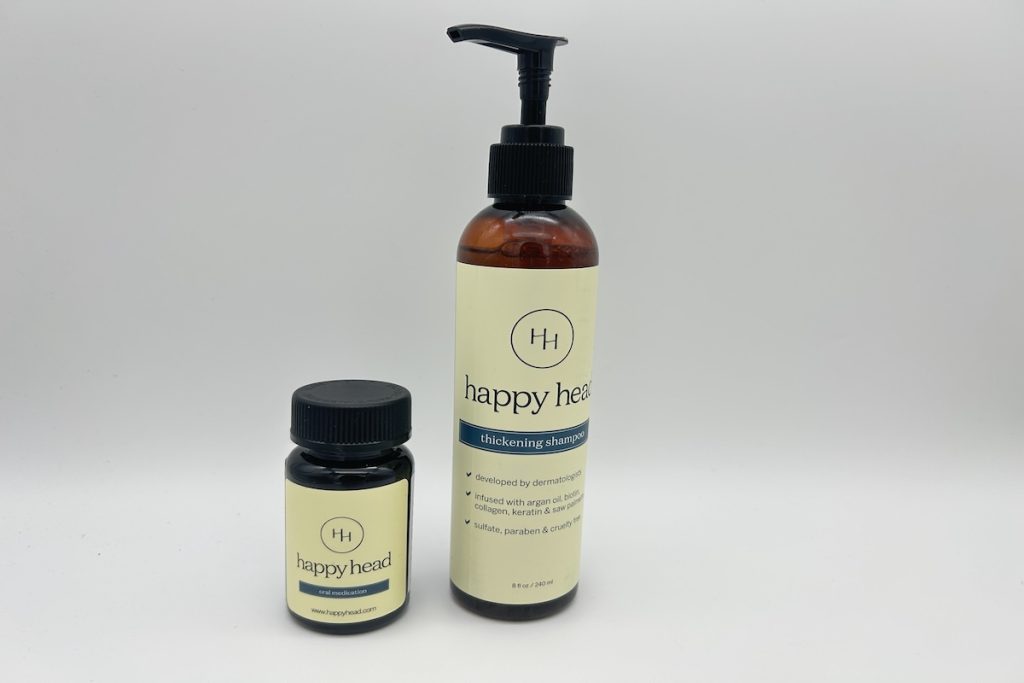
Happy Head offers oral and topical hair loss products that often include extra vitamins. For example, its oral medications include Vitamin D3. It also offers over-the-counter products such as shampoos and conditioners. These are often compounded medications, which means that they are mixed with other medications or prescribed for use that is not FDA approved.
Happy Head’s products are more expensive than those offered by Ro and Hims. This can be important since hair loss treatments are meant to be taken long term for the best results. In our survey of older adults using hair loss medications, more than 1 in 3 respondents (39%) said they stopped taking their prescription medication due to the high cost of their treatments.
One unique feature of Happy Head: users have the option to customize their product or have the dermatologist formulate the product themselves. This means users can contact their Happy Head dermatologist to request an ingredient be removed or the concentration lowered in their product. This can be useful if you are allergic or sensitive to one of the ingredients in a product. And Happy Head is the only platform we tested that offers oral and topical spironolactone as a treatment option.
When we signed up for hair loss treatment on the platform, they noted that Happy Head sent updates of when their treatment request was reviewed and when they were recommended an actual treatment. Subscribers on Happy Head can message their provider at any time through the mobile app or make an appointment for a video call with a provider, in addition to attaching photos with their messages.
Customer reviews of Happy Head
On Trustpilot, Happy Head is rated 4.2 out of five stars, with more than 900 reviews. Many reviewers mention positive experiences with the platform’s customer service. Others shared difficulty canceling their subscriptions.
“Don’t even bother trying to cancel on the website. You’ll have to fill out a bunch of forms via an AI chat bot, then the AI chat bot will inform you have to call to cancel. When you call you will be asked all the same form questions again.”
– Justin, Trustpilot
“I’ve only been using the products for a couple of weeks, so no visible results yet but the customer service agent I spoke with was very helpful. She didn’t have an answer to my question right away but followed up with an email with an answer the same day just a couple hours later.”
– Adams, Trustpilot
Additional information
Happy Head subscriptions are billed every 25 days. It accepts debit and credit cards only.
You can contact Happy Head customer service through the live chat on the lower right corner of its website, by texting 213-464-0214, or by calling 844-962-4247 Monday through Friday, 7 a.m. to 5 p.m. PT.
Nutrafol
One of our testers took Nutrafol’s hair quiz and was recommended a treatment that included its Nutrafol for Women supplement. They noted that the hair quiz did not ask many questions about their health history, and the website didn’t provide much information about who shouldn’t take the product.
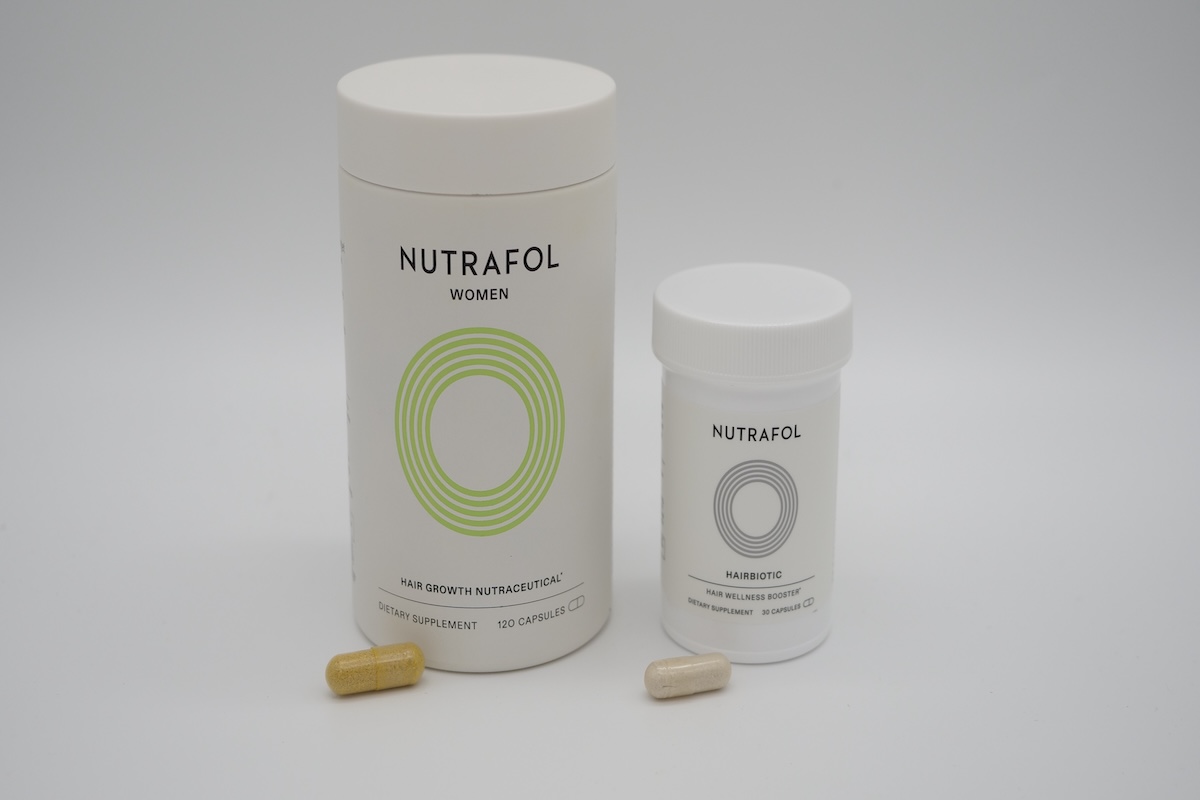
That lack of information can be misleading for people who shouldn’t take Nutrafol, which was the case for another one of our testers. When our tester asked their doctor about whether they could start taking Nutrafol, they were advised that some of the ingredients wouldn’t be appropriate because of their other health conditions. Our tester shared that they wished Nutrafol would have asked questions about health conditions in the questionnaire so that they could know more before buying it.
Users who are sensitive to biotin should consult their health care provider about whether it is safe to take Nutrafol, since biotin is one of its main ingredients. Nutrafol offers a Vegan formulation for those who do not want or are sensitive to biotin.
Nutrafol recommends taking four capsules of its supplement a day. This can be a lot for people who have trouble taking pills or who are sensitive to taste and smells, especially since the brand recommends taking their treatment for at least three months.

Our tester on Nutrafol:
“If you have difficulty swallowing pills, the nutraceutical is not for you. The capsules are massive and they also smell and taste very bad.”
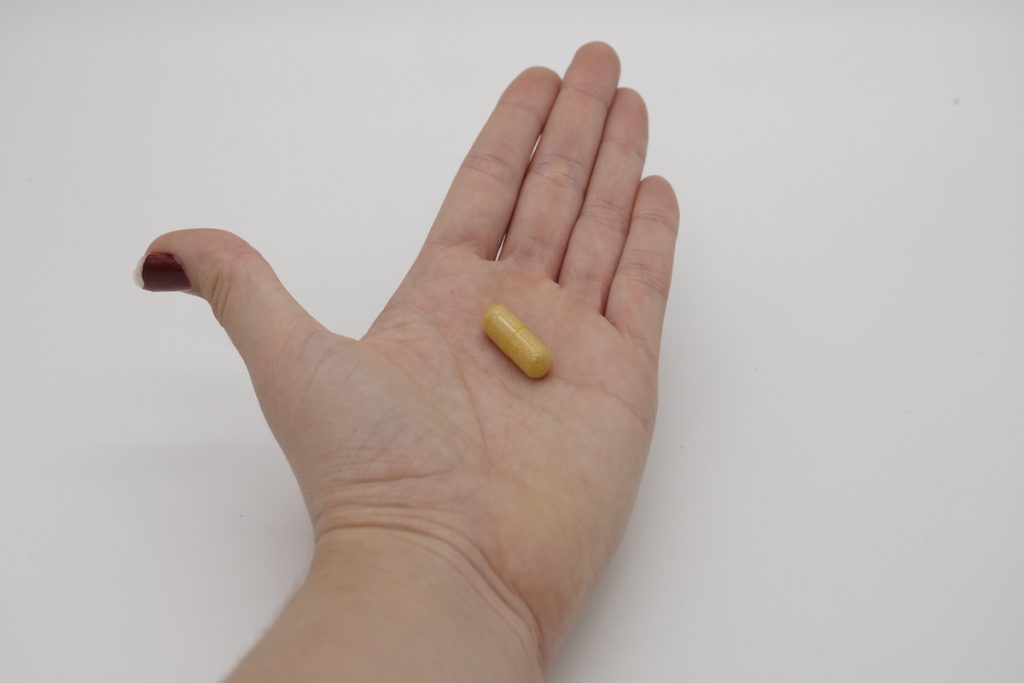
Our testers are currently still testing Nutrafol to understand the long-term experience of using this product for hair growth.
Customer reviews of Nutrafol
On Amazon, Nutrafol for Women is rated 4.2 out of five stars, with more than 17,000 reviews. Some reviewers mention seeing new growth and reduced shedding within one month of use, but others haven’t noticed any changes after three months. Some reviewers didn’t like the taste or smell of the product, and some thought it was too expensive monthly.
“My hair quality has always been decent but never as thick as I wanted them to be. Prior to Nutrafol, on day 2 without washing my hair my scalp would show large gaps or when I tie my hair up you’d see the thinning on the both sides of my head. After I finished my 3-month supplies I’m fully convinced I might have to commit to Nutrafol the rest of my life. It’s surely expensive but I’m just over the moon with my result I’m willing to ignore the price.”
– RJL, verified buyer on 8/21/2024
“I am excited to see if these work. I discovered Nutrafol because it was recommended by a lot of dermatologists that I follow on Instagram. The jar is definitely higher quality than I thought it would be. Not like plastic and almost has a ceramic feel. The capsules smell relatively pleasant and don’t taste bad either but if you are a wimp about swallowing pills these might be challenging. The dose is 4 capsules per day, and I have to work on swallowing them one at a time with big gulps of water. They don’t go down very easily and you definitely can’t swallow more than one at a time so in that regard it can be a bit of a nuisance. However, if it decreases my hair shedding it will be well worth it.”
– Anne B., verified buyer on 5/2/2024
Additional information
Nutrafol offers one-, three-, and six-month subscriptions for its supplements. The cost of each bottle depends on how frequently you’d like it delivered. Subscriptions also include wellness coaching with a naturopathic doctor, a lab test of your hair to help determine the cause of your hair loss, and a free Headspace subscription.
The website accepts credit cards and PayPal. Shipping is free.
Customers can contact Nutrafol by:
- Email: support@nutrafol.com
- Calling or texting: 888-454-3320
How we research hair loss medication and test platforms that offer them
We base our recommendations on the best clinical guidelines and research on hair loss treatments. We talked with dermatologists and trichologists to get their expert recommendations for both prescription and over-the-counter products. We also surveyed hair loss treatment users and interviewed focus groups of users to better understand the experience of hair loss and hair loss treatment.
Our testers signed up for some of the most popular online hair loss treatment platforms, paying special attention to:
- Treatments available, including prescription and over-the-counter options
- Ways to contact a prescriber, for example through messaging or video sessions
- The medical assessment and intake process, if prescribed a medication
- Shipping times
- Costs of subscriptions, products, and consultations
- How easy it is to use the app or website
- Treatment experience
- Customer service
All of our reviews are medically reviewed by a licensed and practicing medical expert to ensure the information is accurate and up to date.
Causes of hair loss
Hereditary hair loss
Hereditary hair loss is also called androgenetic hair loss. Androgenetic hair loss occurs when hormones, specifically androgens, affect hair follicles, resulting in hair thinning or falling out. “It’s not the level of androgens that cause hair loss; it’s the individual’s sensitivity to it,” said Chu.
In men, male-pattern baldness can look like a hairline recession or the development of a bald spot at the top of the head. In women, female-pattern baldness looks like hair thinning and a widening hair part. Genetics, age, and other individual factors can contribute to this type of hair loss. The risk of hereditary hair loss increases with age. More than 50% of men over 50 have some degree of hair loss. Women are more likely to experience hereditary hair loss after menopause.
Hair regrowth is possible with treatment. According to the AAD, the earlier treatment is started, the better it works.
Stressors
Both physical and mental stress can cause hair loss. Examples of physical stress on the hair include friction, hair pulling, tight hairstyles, and repeated hair treatments. Physical stress on the body can cause hair loss as well, which could be brought on by illness or childbirth. Psychological stress, such as separation, divorce, or death of a loved one, can affect hair growth as well.

Tips from experts:
“Maintaining a balanced diet rich in vitamins and minerals, reducing stress through mindfulness or exercise, and avoiding harsh hair treatments or styling can all contribute to healthier hair. Additionally, ensuring proper scalp care, like avoiding excessive use of heat or chemicals, can help preserve the hair you have.” — Ross Kopelman, hair restoration surgeon
According to the AAD, hair regrowth is possible once the stress is removed. Most people can expect to see fuller hair within six to nine months after hair has stopped shedding in response to stress.
Health conditions that cause hair loss
There are many health conditions that can cause hair loss, including:
- Thyroid disorders, such as hypothyroidism
- Infections, such as scalp infections or sexually transmitted infections like syphilis
- Autoimmune disorders, such as alopecia universalis
- PCOS
Nutrient deficiencies in biotin, iron, protein, or zinc may also cause hair loss. Changes in hormones during menopause may also contribute to hair loss.
Depending on the cause of the hair loss, hair regrowth may be possible if the condition is managed. In the case of hair loss that results in scarring of the scalp, hair regrowth is not possible.
Cancer treatment or medications
Chemotherapy and radiation treatment may affect your hair follicles. Hair regrowth typically starts after chemotherapy or radiation therapy is finished.
Some medications cause hair loss as a side effect. For example, certain acne medications, antidepressants, birth control pills, cholesterol-lowering drugs, or high blood pressure medications may cause hair loss.
When to speak to a doctor about hair loss
Hair loss can have many causes, and it might not be as simple as male- or female-pattern hair loss. If you’re concerned about your hair loss, Chu recommends talking to your doctor as soon as you start noticing hair thinning or hair loss.
“Getting the right diagnosis is very important,” said Chu. “There are a lot of people I see who come in with suspected pattern hair loss, and they have something else.” Medical professionals such as board-certified dermatologists can order the right lab tests and perform the right examinations to pinpoint the cause of hair loss. From there, they can offer individualized guidance on the treatment options that are available and most appropriate.
Table 1, Compare the best hair loss medication platforms of 2025
| Medications available | Minoxidil, finasteride, ketoconazole (topical only) | Minoxidil, finasteride, ketoconazole (topical only) | Minoxidil, finasteride, and tretinoin (topical only) | Minoxidil | Minoxidil, finasteride, dutasteride, spironolactone, retinoic acid | Nutrafol herbal supplements |
| Types of medication | Oral, topical | Oral, topical | Oral, topical | Oral, topical | Oral, topical | Oral |
| Starting monthly cost online (oral) | $35 | $29 | $20 | $16 | $22 | $70 |
| Subscription options | Three or six months | Three or six months | Three months | Three or four months | Monthly | Monthly, three months, or six months |
* In a compounded formula
Bottom line
According to our research and discussions with experts, we found that minoxidil, finasteride, and spironolactone are some of the most commonly prescribed hair loss medications. These medications treat hair loss by stimulating hair growth, minimizing hair loss, and addressing how hair follicles respond to hormones. Nutrafol is a dietary supplement with research behind its safety and effectiveness, which is why some dermatologists also recommend it as an option.
Hims, Hers, Ro, Nurx, and Happy Head are popular online platforms that offer hair loss medications. After reviewing our tester and user feedback, it’s clear that successful hair loss treatment requires time, commitment to a routine, and a personalized approach.
Dermatologists and hair specialists play an important role in helping patients understand their hair loss and treatment options, guiding them toward a more successful outcome. Chu emphasizes that hair loss treatment is different for each person, and setting realistic expectations is key before starting long-term treatment.
Frequently asked questions
The best medication or treatment plan for hair loss depends on someone’s underlying cause of hair loss and response to treatment. Common and effective medications for hair loss include minoxidil, finasteride, and spironolactone.
Whether hair can grow back after thinning depends on the cause and current treatment. Dermatologists are able to help investigate the causes of hair thinning and loss and recommend treatments that can support hair regrowth.
Hair loss is a symptom people typically notice on their own, and there may be patterns of hair loss that can point to the underlying cause. Dermatologists can diagnose the cause of hair loss through a comprehensive intake of someone’s medical history, examination, and testing.
Sources
- Ho CH, et al. Androgenetic Alopecia. StatPearls [Internet]. Jan. 7, 2024. https://www.ncbi.nlm.nih.gov/books/NBK430924/
- MedlinePlus. Minoxidil Topical. Nov.15, 2017. https://medlineplus.gov/druginfo/meds/a689003.html
- MedlinePlus. Minoxidil. Jan.15, 2018. https://medlineplus.gov/druginfo/meds/a682608.html
- Suchonwanit P, et al. Minoxidil and Its Use in Hair Disorders: A Review. Drug Design, Development, and Therapy. Aug. 9, 2019. https://www.dovepress.com/minoxidil-and-its-use-in-hair-disorders-a-review-peer-reviewed-fulltext-article-DDDT
- Penha MA, et al. Oral Minoxidil vs Topical Minoxidil for Male Androgenetic Alopecia. A Randomized Clinical Trial. JAMA Dermatology. April 10, 2024. https://jamanetwork.com/journals/jamadermatology/article-abstract/2817326
- Patel P, et al. Minoxidil. StatPearls [Internet]. Aug. 18, 2024. https://www.ncbi.nlm.nih.gov/books/NBK482378/
- American Academy of Dermatology Association. Hair Loss: Diagnosis and Treatment. Dec. 13, 2022. https://www.aad.org/public/diseases/hair-loss/treatment/diagnosis-treat
- NCOA Hair Loss Survey. 275 respondents. Conducted using Pollfish. Launched August 2024.
- Mayo Clinic. Minoxidil (Topical Route). Feb. 1, 2024. https://www.mayoclinic.org/drugs-supplements/minoxidil-topical-route/before-using/drg-20068750
- MedlinePlus. Finasteride. June 15, 2022. https://medlineplus.gov/druginfo/meds/a698016.html
- Piaccini BM, et al. Efficacy and Safety of Topical Finasteride Spray Solution for Male Androgenetic Alopecia: A Phase III, Randomized, Controlled Clinical Trial. Journal of European Academy of Dermatology and Venereology. Oct. 11, 2021. https://onlinelibrary.wiley.com/doi/10.1111/jdv.17738
- MedlinePlus. Spironolactone. Feb. 15, 2018. https://medlineplus.gov/druginfo/meds/a682627.html
- Cumming DC, et al. Treatment of Hirsutism with Spironolactone. JAMA. March 5, 1982. https://jamanetwork.com/journals/jama/article-abstract/368969
- Aleissa, M. The Efficacy and Safety of Oral Spironolactone in the Treatment of Female Pattern Hair Loss: A Systematic Review and Meta-Analysis. Cureus. Aug. 16, 2023. https://www.cureus.com/articles/166490-the-efficacy-and-safety-of-oral-spironolactone-in-the-treatment-of-female-pattern-hair-loss-a-systematic-review-and-meta-analysis#!/
- Food and Drug Administration. Dietary Supplements. Feb.21, 2024. https://www.fda.gov/food/dietary-supplements
- MedlinePlus. Androgenetic Alopecia. July 27, 2023. https://medlineplus.gov/genetics/condition/androgenetic-alopecia/
- American Academy of Dermatology Association. Hair Loss: Who Gets and Causes. https://www.aad.org/public/diseases/hair-loss/causes/18-causes
- Watson S. Medications that can Cause Hair Loss. WebMD. July 12, 2022. https://www.webmd.com/skin-problems-and-treatments/hair-loss/drug-induced-hair-loss-2
- Ablon, G and Kogan, S. A Six-Month, Randomized, Double-Blind, Placebo-Controlled Study Evaluating the Safety and Efficacy of a Nutraceutical Supplement for Promoting Hair Growth in Women With Self-Perceived Thinning Hair. Journal of Drugs in Dermatology. May 1, 2018. https://pubmed.ncbi.nlm.nih.gov/29742189/


